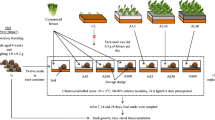Summary
-
1.
In Helix pomatia the efficiency of assimilation of both food (lettuce) and copper is always high, even when the food has been artificially enriched with copper. In short-term feeding experiments with lettuce containing 1390 (±420)ppm copper about 97% of the metal ingested remains in the snail.
-
2.
The availability of copper in the faeces is independent of the type of food and does not differ much from the availability of the metal in untreated lettuce. About half of the metal can be extracted by 0.1 M HCl, whereas the other half is liberated only by ashing.
-
3.
The concentration of copper in the organs of a natural population of H. pomatia varied between 20 and 120 ppm (dry weight). Being by far the largest organ the foot contains most of this copper. After the snails have fed on copper-enriched food for three weeks the concentration of copper increases mainly in the alimentary tract and in the midgut gland, but no one organ is capable of concentrating copper to a much higher degree than another. In winter animals which had been feeding on copper-enriched food prior to hibernation, the concentration of copper in several organs may reach values that are from 10 to 40 times higher than those in summer animals.
-
4.
When snails begin to feed on copper-enriched food the concentration of the metal increases quickly in the anterior alimentary tract. After three days a striking increase in the midgut gland takes place, followed, after five days, by a further accumulation of copper in the tissues of the alimentary tract, mainly of the intestine. In the albumen gland and in the foot the concentration of copper remains more or less constant.
-
5.
In midgut and albumen gland more than 90% of the total copper is so tightly bound that it can be liberated only by ashing, whereas in the walls of the alimentary tract between 55 and 70% of the copper can be extracted with 0.1 M HCl.
-
6.
If gastropods and isopods are compared with regard to the efficiency of their assimilation of copper it can be shown that this remains high as long as the ingestion of food (dry weight) does not exceed approximately 3% of fresh body weight per day.
Similar content being viewed by others
References
Brown, N.A., Hemingway, R.G.: A rapid method for the determination of copper in biological tissues by means of zinc-dibenzyldithiocarbamate. Res. vet. Sci. 3, 345–347 (1962)
Coombs, T.L.: Uptake and storage mechanisms of heavy metals in marine organisms. Proc. analyt. Div. chem. Soc. 14, 219–222 (1977)
Coughtrey, P.J., Martin, M.H.: The distribution of Pb, Zn, Cd and Cu within the pulmonate mollusc Helix aspersa Müller. Oecologia (Berl.) 23, 315–322 (1976)
Coughtrey, P.J., Martin, M.H.: The uptake of lead, zinc, cadmium and copper by the pulmonate mollusc, Helix aspersa Müller, and its relevance to the monitoring of heavy metal contamination of the environment. Oecologia (Berl.) 27, 65–74 (1977)
Dallinger, R.: The flow of copper through a terrestrial food chain. III. Selection of an optimum diet by isopods. Oecologia (Berl.) 30, 273–276 (1977)
Dallinger, R., Wieser, W.: The flow of copper through a terrestrial food chain. I. Copper and nutrition in isopods. Oecologia (Berl.) 30, 253–264 (1977)
De Jorge, F.B., Haeser, P.E.: Further biochemical studies on the snail Strophocheilus oblongus musculus Becquaert, 1948. Comp. Biochem. Physiol. 26, 627–637 (1968)
Fischer, P.-H.: Recherches sur la vie ralentie de l'escargot (Helix pomatia L.). J. Conchyliologie 75, 5–100, 111–200 (1931)
Jennings, J.R., Rainbow, P.S., Scott, A.G.: Studies on the uptake of cadmium by the crab Carcinus maenas in the laboratory. II. Preliminary investigation of cadmium-binding proteins. Mar. Biol. 50, 141–149 (1978)
Jordan, H.: Vergleichende Physiologie wirbelloser Tiere. 1. Bd. Die Ernährung. pp. 738 Jena: Gustav Fischer 1913
Mansour-Bek, J.J.: Über die proteolytischen Enzyme von Murex anguliferus Lamk. Z. vgl. Physiol. 20, 343–369 (1934)
Meincke, K.-F., Schaller, K.-H.: Über die Brauchbarkeit der Weinbergschnecke (Helix pomatia L.) im Freiland als Indikator für die Belastung der Umwelt durch die Elemente Eisen, Zink und Blei. Oecologia (Berl.) 15, 393–398 (1974)
Noel-Lambot, F.: Distribution of cadmium, zinc and copper in the mussel, Mytilus edulis. Existence of cadmium-bindings proteins similar to metallothioneins. Experientia 32, 324–326 (1976)
Noel-Lambot, F., Gerday, Ch., Disteche, A.: Distribution of Cd, Zn and Cu in liver and gills of the eel Anguilla anguilla with special reference to metallothioneins. Comp. Biochem. Physiol. 61C, 177–187 (1978)
Nopp, H.: Physiologische Aspekte des Trockenschlafes der Landschnecken. Sitz. ber. Österr. Akad. Wiss. mathem.-naturw. Kl. Abt. I, 182, 1–75 (1974)
Richardson, A.M.M.: Food, feeding rates and assimilation in the land snail Cepaea nemoralis L. Oecologia 19, 59–70 (1975)
Weischer, M.-L.: Stoffwechselphysiologische Untersuchungen zur Bedeutung des Haemocyanins bei Helix pomatia L. Zool. Beitr. (Berlin) N. F. Bd. 11, 517–540 (1965)
White, J.J.: Bio-energetics of the woodlouse Tracheoniscus rathkei Brandt in relation to litter decomposition in a deciduous forest. Ecology 49, 694–704 (1968)
Wieser, W.: Consumer strategies of terrestrial gastropods and isopods. Oecologia (Berl.) 36, 191–202 (1978)
Wieser, W.: The flow of copper through a terrestrial food web. In: The biogeochemistry of copper (J.O. Nriagu, ed.) New York: Wiley (in press) (1979)
Wieser, W., Dallinger, R., Busch, G.: The flow of copper through a terrestrial flood chain. II. Factors influencing the copper content of isopods. Oecologia (Berl.) 30, 265–272
Wieser, W., Klima, J.: Compartmentalization of copper in the hepatopancreas of isopods. Mikroskopie 24, 1–9 (1969)
Williamson, P.: Factors influencing the levels of lead, zinc and cadmium in a roadside population of the snail Cepaea hortensis Müller, Oecologia (Berl.) (in press) (1979)
Williamson, P., Cameron, R.A.D.: Natural diet of the landsnail Cepaea nemoralis. Oikos 27, 493–500 (1976)
Author information
Authors and Affiliations
Additional information
Supported by the “Fonds zur Förderung der wissenschaftlichen Forschung in Österreich”, project no. 1851
Rights and permissions
About this article
Cite this article
Moser, H., Wieser, W. Copper and nutrition in Helix pomatia (L.). Oecologia 42, 241–251 (1979). https://doi.org/10.1007/BF00344860
Received:
Issue Date:
DOI: https://doi.org/10.1007/BF00344860




